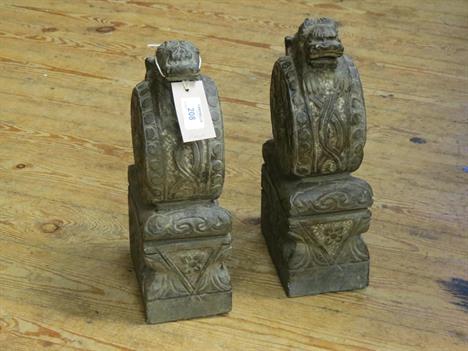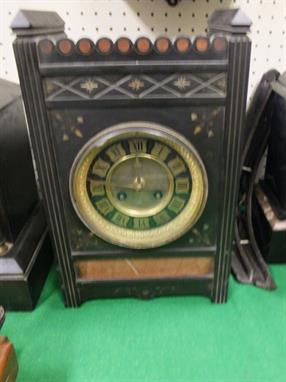We found 35023 price guide item(s) matching your search
There are 35023 lots that match your search criteria. Subscribe now to get instant access to the full price guide service.
Click here to subscribe- List
- Grid
-
35023 item(s)/page
WILLIAM CHAPMAN "Observations on the Various Systems of Canal Navigation, with Inferences Practical and Mathematical in which Mr Fulton's Plan of Wheel Boats and the Utility of Subterraneous and of Small Canals are particularly investigated, including an Account of the Canals inclined Planes of China" published by I and J Taylor at The Architectural Library High Holborn 1797, marbled boards with leather spine CONDITION REPORTS Pages overall with browning and foxing. Some tattiness and creasing to edges. Map with print from opposing pages having leeched through. Library stamps to reverse of map and pictures which is visible from the front of the maps and pictures. Some pages with small tears and losses to edges, particularly to the first title page. Various inked library stamps throughout the volume. Also various pen crossings out and corrections to the text. Various library stamps and stickers. Later boards and spine.
AFTER B COLE "To the Rt. Honble Slingsby Bethel Esq., Lord Mayor to the Rt. Worshipful Court of Aldermen and Comon Council of City of London, These designs for building a bridge with stone to cross the River Thames from Blackfryers, London to Southwark in Surry, Is most humbly inscribed by your Hon. most obedient humble servant Edward Oakley", a black and white architectural engraving by Edward Oakley, published February 1756, image size 34 cm x 41 cm
A 19th Century mahogany architectural library bookcase:, the upper part with a moulded broken arch pediment and dentil cornice, enclosed by a pair of central glazed panel doors, flanked by an enclosed cupboard to either side, each with a fielded panel door, the lower part with a reeded edge, containing four central drawers flanked by an enclosed fielded panel cupboard to either side, on a plinth base, 195cm (6ft 4 3/4in) wide, 260cm (8ft 6 1/4in) high.
A 19th Century French mahogany secretaire a abbatant:, surmounted by a panel of green variegated marble, having a moulded cornice and carved frieze with leaf and berry ornament, fitted with a frieze drawer, the octagonal panelled hinged fall enclosing a shaped and boxwood strung architectural fitted interior in mahogany and burr maple with an arrangement of drawers about a central enclosed stepped and columned cupboard, containing three long drawers below, on bracket feet, 117cm (3ft 10in) wide, 153cm (5ft 0 1/4in) high.
Victorian style mahogany breakfront bookcase of architectural proportion 93" high (with corneis 105"), 100" wide and 24.5" deep Age: second half of 20th century Condition: general wear condusive to use, some surface scratches most notable to the top of the base Manufacturer: unknown but is reproduction Combination of solid mahogany and veneer.
Victorian style mahogany breakfront bookcase of architectural proportion 93" high (with corneis 105"), 100" wide and 24.5" deep Age: second half of 20th century Condition: general wear condusive to use, some surface scratches most notable to the top of the base Manufacturer: unknown but is reproduction Combination of solid mahogany and veneer.
An oak press cupboard, late 17th/early 18th century, the moulded cornice above the acanthus carved frieze with central carved initials “GL” and dated “1733”, flanked by turned pendant terminals, central panel with carved architectural arch detail, a pair of conforming panelled doors on either side, the lower section with a pair of fluted drawer and guilloche carved frieze, a pair of lozenge and scroll carved twin panelled doors, on stile feet, 176cm high, 155cm wide, 57cm deep For a number of closely related examples see Victor Chinnery, Oak Furniture, The British Tradition, Antique Collectors Club 1979
An Empire mahogany secretaire abbatant, circa 1810, the architectural frieze above a drawer and oval panelled hinged fall, opening to central cupboard door, flanked by pigeon holes and small drawers, three further drawers, flanked by gilt metal mounted pilasters, square section feet, 153cm high, 116cm wide, 59cm deep
A Continental walnut and ebonised table cabinet, late 17th/ early 18th century, probably Flemish or Dutch, the central cupboard door decorated with a carved architectural arch and flanked by figures, opening to three drawers concealing three secret drawer, flanked by two further small cupboard doors and an arrangement of four small drawers, plinth base, 46cm high, 56cm wide, 33cm deep Provenance: The Property of the late Baron Osy de Zegwaart.
SUITE DE QUATRE CAPRICES D’ARCHITECTURE Attribués à Giuseppe Galli Bibiena (Parme, 1696 - Berlin, 1756) Italie, premier tiers du XVIIIe siècle, vers 1720-1730 MATÉRIAU : Toiles H. 190 cm, L. 130 cm chaque FOUR ITALIAN ARCHITECTURAL “CAPRICCIO” Attributed to Giuseppe GALLI BIBIENA (1696-1756), C. 1720-1730 74.80 in. high, 51.18 in. wide each Cette rare suite de quatre toiles peintes en grisaille avec rehauts de couleurs sont attribuées à Giuseppe Bibiena qui fut notamment Directeur de l’Academia Clementina à Bologne, Architecte de la Cour de Vienne puis de Frédéric II de Prusse à Berlin. Chaque oeuvre montre de vastes espaces architecturés inspirés de l’Antiquité, intérieurs ou extérieurs, animés de quelques personnages dont la petite taille donne toute la monumentalité aux bâtiments qui les entourent. Ce travail, emprunt d’onirisme, se retrouve dans plusieurs oeuvres attestées du maître connues sous forme de gravures de dessins ou peintes que l’on peut observer notamment dans de prestigieuses collections allemandes . De son vivant, Bibiena était déjà célébré par ses contemporains pour son Œuvre de décorateur de théâtre, de dessinateur, de peintre et d’architecte à l’instar de son père, de ses frères et de son oncle, de l’Italie à l’Autriche. Il réalisa de grands décors de mariage ou de cérémonies funèbres et fut décorateur de nombreux châteaux. Il est connu pour ses somptueux décors de mariages ou de cérémonies funèbres, pour ses machineries de théâtres et ses scénographies. Il a également construit des théâtres et décoré bon nombre de châteaux. À partir de 1753, il fut engagé par le roi Frédéric II de Prusse et termina sa vie à Berlin en qualité d’Architecte de Cour.
A substantial medium oak sideboard, the upper section enclosing a central rectangular mirror plate with moulded outline flanked by open shelves and architectural pediment with carved scrolling foliate detail, the lower section with inverted breakfront with carved acanthus outline over shallow frieze drawer, recess and central plain cupboard flanked by a pair of cupboards with turned column supports, all set on a plinth base
A large quantity of mainly press photographs, many bearing the copyright of the camera press in London, to include items of architectural interest,celebrities to include Peter Sellers, Pablo Picasso, John Lennon, Brigite Bardot, Julie Christie, Natalie Wood, Church interiors, Political figures to include Mao Tse-Tung, Bernadette Devlin, Amin, etc, and some slides.
Jacques de Lajoue (French 1687-1761), AN ARCHITECTURAL CAPRICCIO WITH A CLASSICAL MONUMENT OF OBELISK FORM, SURMOUNTED BY THE THREE GRACES SUPPORTING AN EWER Signed l.r., pencil, pen and ink and grey wash 36.5 x 24cm CONDITION REPORT: A few small spots of foxing. Brown stains to left hand side of obelisk beneath arch. Not viewed out frame.
A George II mahogany hall bench, c.1730, the design attributed to William Kent, with a double-panelled back, a scrolled top and arm terminals above a double arched acanthus leaf carved apron, foliate carved legs and scrolled feet, 140cm wide 60cm deep 101cm high Provenance: Purchased from Christopher Gibbs in the late 1970s. Benches of this type, conceived in an architectural manner and intended to stand in formal entrance halls, are associated with the English Palladian Revival of the late 1720s and 1730s, and in particular with houses where the architect/designer William Kent worked. Some are of painted deal or oak, but most surviving examples are mahogany. Mahogany benches have been recorded at Houghton Hall, Boughton House, Badminton House, Devonshire House, Raynham Hall, Wentworth Woodhouse and Sherborne House (Glos.), although some are no longer in situ. While all are of a broadly similar form, the benches differ in style and detail, and probably emanated from more than one workshop. Those made for Sherborne House are attributed to James Moore Jnr., who supplied in 1731 '… 2 Mahogany Settees for ye Dining Room at ye Lodge Carved…' at a cost of £30. Their design is attributed to William Kent, who provided plans for Sherborne Lodge and House in 1728; it was later published in a slightly modified version by John Vardy in 'Some Designs of Mr Inigo Jones and Mr William Kent'. Almost identical benches were once at Devonshire House and a similar set of four benches were made for the Duke of Montagu's house in Whitehall and are now at Boughton House, Northamptonshire. They are closely similar to the Sherborne benches but are attributed, not to Moore, but to his contemporary James Nix. A similar, single bench is on the Great Stairs at Houghton Hall. The present bench has some similarities with the Sherborne and Montagu House examples, specifically in the design of the front legs, but its back and arms relate much more closely to the set of six benches at Houghton Hall, Norfolk, whose design is attributed to William Kent. Indeed, this is the only known example which shares the distinctive scrolled-over back of the Houghton benches. It also has a similar arched, leaf-carved apron below the seat. The apron is carried to the floor at each end, forming scrolled trusses at right angles to the front legs. The result is highly decorative, but also, from a structural point of view, immensely strong. The seat construction, with its single board resting on a coved frame, is identical, as is the design of the scrolled arm terminals. The principal differences are in decorative treatment; the present bench has a highly enriched apron but plain mouldings beneath the seat and around the back and side panels. The similarities are sufficiently compelling as to suggest a common source. No bills survive to reveal the maker of the Houghton benches, but they might have come from the workshop of James Richards, to whom is attributed much of the carved work at Houghton. Richards was appointed in 1721 'Master Sculptor and Carver in Wood' to George I, and he is known to have worked closely with Kent on several commissions. We would like to thank Dr. Adam Bowett for his assistance in cataloguing this lot.
A high Gothic French oak bookcase, mid 19th century, the moulded cornice over a pair of glazed doors with Gothic carved astragals of architectural form, flanked by pinnacles, the pair of doors below with blind tracery 'window' carving and eight relief figures emblematic of trades, containing a drawer and two trays, the sides also with ornate Gothic blind tracery carving, 140cm wide 69cm deep 238cm high CONDITION REPORT: Good overall. Cornice possibly an old replacement? Ring mark on surface. One glass pane cracked.
Giovanni Battista Piranesi (Italian 1720-1788), EIGHTEEN DOUBLE PAGES OF ENGRAVINGS OF CAPITALS AND ELEVATIONS AND OTHER ARCHITECTURAL DETAILS FOR THE CHIESA DI S.PIETRO DELLA CITTA D'ELVANO, 'LES PLUS BEAUX MONUMENTS DE LA GRECE' Sheet size 54 x 78cm (18) CONDITION REPORT: Probably 19th century Paris Edition.
A George III secretaire bookcase with dentilled broken architectural pediment centred by a carved rampant lion holding a shield, this above a pair of 15 panel lattice glazed doors opening on to four adjustable shelves with moulded concave fronts, the base with a top fitted fall front drawers and four long graduated drawers on bracket feet, height 243cm. (See illustration)
-
35023 item(s)/page

























































